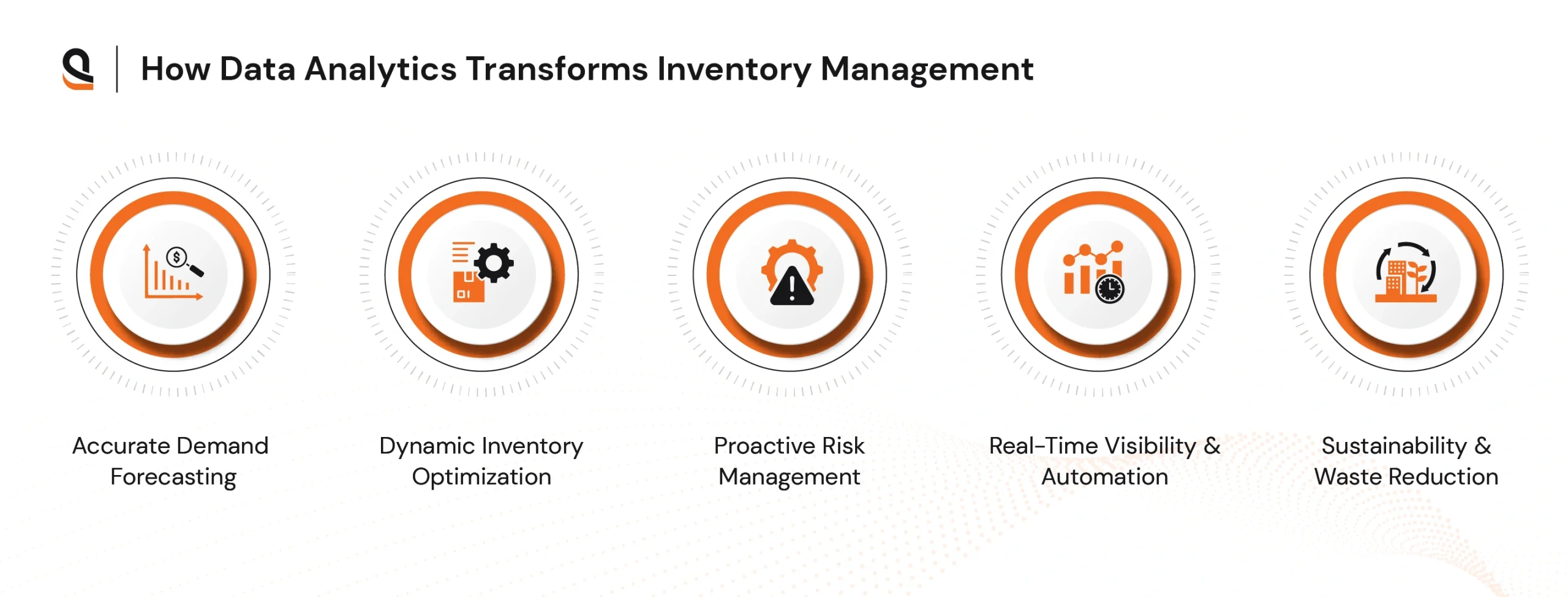
Inventory mismanagement costs manufacturers a jaw-dropping $1.1 trillion every year—an invisible drain on profits and growth. It’s even concerning that 43 % of companies deal with inventory problems while 34% experience stock shortages, resulting in decreased sales and operational drawbacks. In a time when supply chains are becoming increasingly complex issues are not expensive. Also pose a threat, to the survival of businesses.
Predictive analytics in manufacturing gains control over their inventory, reduces waste, and establishes a new standard of smarter, more efficient operations. With predictive analytics, it is now possible for manufacturers to minimize their inventory holding costs by up to 25% and reduce waste by up to 30%.
Let us see some better transformational change in predictive analytics in manufacturing regarding inventory data management, what trends are expected to be adopted in 2025, and how businesses can overcome challenges to meet their targets.
The Role of Predictive Analytics in the Manufacturing Industry and Inventory Data Management
With predictive analytics, which makes use of data models, real-time feedback, and machine learning, manufacturers can respond quickly to a changing demand and maintain inventory levels for smoother and more efficient operations.
- Anticipates demand fluctuations.
- Reduces overstocking and understocking.
- Minimizes waste and storage costs.
- Enhances supply chain resilience.
In today’s manufacturing environment which is constantly evolving and becoming more intricate to navigate effectively through predictive inventory management challenges without analytics would be nearly impossible.
Key Business Objectives for Manufacturers in 2025
As manufacturers prepare for 2025, several business objectives will drive their strategies:
- Cost Optimization: Reduce the cost of predictive inventory management and minimize waste.
- Operational Efficiency: Technology in the streamlining process would ensure productivity enhancement and reduction in downtime.
- Customer Satisfaction: Making timely deliveries and meeting customer expectations.
- Sustainability: Bringing operations on board with environmental goals through waste and energy reduction.
- Resilience: Complete supply chains capable of withstanding disruptions in this volatile market.
Despite all the promises that predictive analytics hold, the manufacturing industries will face challenges in the implementation of a prime inventory data management and stocking methodology.
Challenges in Inventory Data Management and Predictive Analytics in Manufacturing Industry
1. Demand Volatility – Fluctuating customer demand and market uncertainties make it difficult to maintain optimal stock levels without leveraging predictive inventory management.
2. Supply Chain Disruptions – Global supply chain disruptions, as seen during the pandemic, continue to pose risks to inventory availability, highlighting the need for predictive inventory management to anticipate and mitigate delays.
3. Overstocking and Understocking – Excess inventory ties up capital, while stockouts lead to production delays and lost sales—challenges that predictive inventory management helps balance effectively.
4. Lack of Real-Time Visibility – Manual processes and siloed data systems hinder real-time decision-making, whereas predictive inventory management enables proactive and data-driven responses.
5. Sustainability Pressures – Increasing regulatory and consumer demands for sustainable practices add complexity to inventory data management, making predictive inventory management essential for optimizing stock with minimal waste.
How Predictive Analytics in Manufacturing Industry Transforms Predictive Inventory Management Overall
Predictive analytics in manufacturing industry offers tailored solutions to address these challenges and achieve business objectives. Here’s how:
 1. Accurate Demand Forecasting
1. Accurate Demand Forecasting
Analyzing historical data alongside market trends and external factors, predictive inventory management delivers demand forecasts with data accuracy. Manufacturers can avoid both overstocking and understocking quantities by using these forecasts to match production and inventory levels with actual market demand through predictive inventory management.
2. Dynamic Inventory Optimization
Predictive systems adjust stock levels in real-time, just-in-time replenishment and holding costs are minimized through this process. Companies that implement predictive inventory data management have observed a 25% decrease in inventory carrying costs.
3. Proactive Risk Management
Predictive models detect possible supply chain disruptions ahead of time so manufacturers can act preemptively for continuity.
4. Real-Time Visibility and Automation
Real-time insight into inventory levels is provided by predictive analytics when it is integrated with IoT devices and ERP systems. The system becomes more efficient through automated product replenishment triggers and production adjustments.
5. Sustainability and Waste Reduction
Predictive analytics in manufacturing decreases waste by precisely controlling overproduction and optimizing resource use toward sustainability objectives. Predictive models resulted in a 30% waste reduction according to research from Deloitte. AI technology, along with advanced machine learning solutions, will produce highly precise predictions across demand forecasting as well as equipment maintenance applications.
Predictive Analytics in Manufacturing Industry – Trends to Adapt in 2025
In 2025, several trends will shape the adoption and impact of predictive analytics in manufacturing industry:
- Integration with IoT and Smart Factories – The Internet of Things and smart factories will feed live data streams into predictive analytics, making it more precise and more timely.
- Personalized Customer Demand – Forecasting niche product demand and optimizing inventory levels will help predict artificial needs using predictive analytics in manufacturers.
- AI-Driven Predictive Models – Innovative and advanced artificial intelligence along with machine learning algorithms will make predictions far more accurate, whether it’s anticipating demand patterns or scheduling maintenance needs. As manufacturers embrace these intelligent capabilities, AI in Manufacturing: Key Use Cases to Watch in 2025 will shape how factories operate, optimize resources, and respond to market changes.
- Focus on Sustainability – Predictive analytic practices will be employed in the inventory management systems to meet their overall goals of sustainability, such as reduction of carbon emissions and waste materials in the production lines.
- Reshoring and Localized Supply Chains – Predictive analytics will be core for optimizing local supply chains and inventory management as companies relocate production to home markets to reduce global risks.
Wrap Up
We are a trusted manufacturing IT solutions provider that help enterprises in leveraging the full capabilities of predictive analytics to manufacturing. Moreover, we provide tailored solutions based on the specific challenges that an enterprise face and not only them but also measure results so they always have the upper hand.
 1. Accurate Demand Forecasting
1. Accurate Demand Forecasting